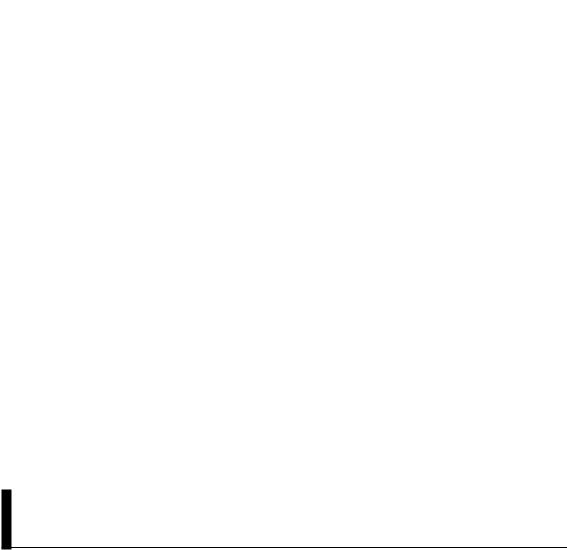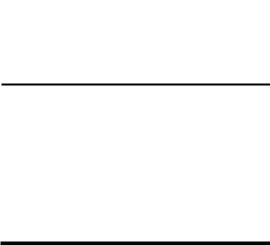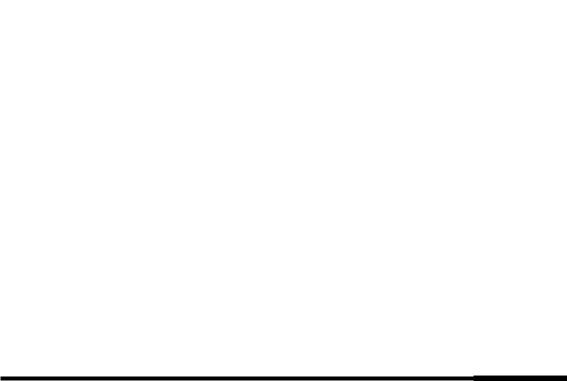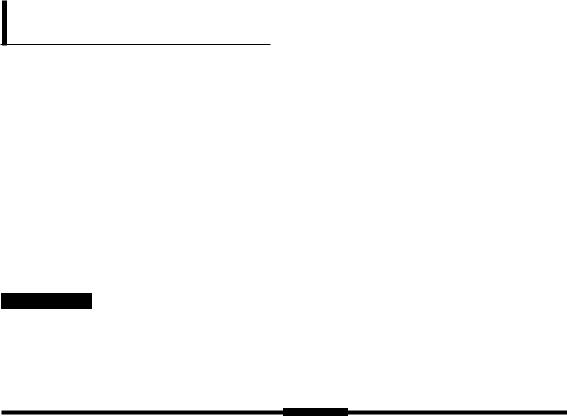
International_Economics_Tenth_Edition (1)
.pdf
(1)Show graphically the effect of the tariff on the overall supply schedule of steel.
(2)With the tariff, the domestic price of
steel rises to $ |
per ton. |
At this |
|
price, |
U.S. buyers purchase |
_ |
|
tons, |
U.S. producers supply |
_ |
|
tons, and |
tons are imported. |
||
(3)Calculate the reduction in U.S. consumer surplus due to the tariff-induced price of steel, as well as the consumption, protective, redistribution, and domestic rev-
4.1 The U.S. International Trade Commission Web site contains information about u.s. tariffs, as well asmany documents that addresscontemporary issues in international economics. Examine the searchable version of the "Harmonized Tariff Schedule of the United States" or various publications on international economics by setting your browser to this URL:
http://www.usitc.gov/webpubs.htm
4.2 The Web site of the U.s. Department of Commerce/Bureau of Industry and Security provides information on U.S. export controls, including restrictions on exports of nuclear weapons and financial servicesencryption products. Set your browser to this URL:
http://www.bxa.doc.gov
4.3 U.S. embassy staffs prepare the
Country Commercia/ Guides once a year.
|
Chapter 4 |
139 |
enue effects. The deadweight welfare loss |
|
|
of the tariff equals $ |
. |
|
(4)By reducing the volume of imports with the tariff, the United States forces the
price |
of imported steel down to |
$ |
. The U.S. terms of trade thus |
(improves/worsens), which leads to (an increase/a decrease) in U.S. welfare. Calculate the terms-of-trade effect.
(5)What impact does the tariff have on the overall welfare of the United States?
They report the business and economic situation of foreign countries and the political climate as it affects U.s. business. To get information on topics suchasmarketing, trade regulation, investment climate, and business travel, set your browser to this URL:
htt.p://www.export.gov/comm_svc/index.
html
4.4 Reports issued by the Office of the United States Trade Representative (USTR) and related entities on the National Trade Estimate Report on Foreign Trade Barriers can be found at this Web site:
http://www.ustr.gov/
4.5 The Sectoral and Trade Barriers Database of selected countries prepared by the European Union can be accessed by setting the browser to this URL:
http://mkaccdb.eu.int
To access NetLink Exercises and the Virtual Scavenger Hunt, visit the Carbaugh Web site at http.r/carbaugh.swleamtng.com.
Log onto the Carbaugh Xtra! Web site (http://carbaughxtra.swlearning.com) Xtra! for additional learning resources such as practice quizzes, help with graphing,
CARBAUGH and current events applications.

Nontariff Trade
Barriers
This chapter considers policies other than tariffs that restrict international trade. Referred to as nontariff trade barriers (NTBs), such measures have been on the rise
since the 1960s and have become the most widely discussed topics at recent rounds of international trade negotiations. Indeed, the post-World War II success in international negotiations for the reduction of tariffs has made remaining NTBs even more visible.
NTBs encompass a variety of measures. Some have unimportant trade consequences; for example, labeling and packaging requirements can restrict trade, but generally only marginally. Other NTBs significantly affect trade patterns; examples include import quotas, voluntary export restraints, subsidies, and domestic content requirements. These NTBs are intended to reduce imports and thus benefit domestic producers.
IImport Quota
An import quota is a physical restriction on the quantity of goods that may be imported during a specific time period; the quota generally limits imports to a level below that which would occur under free-trade conditions. For example, a quota might state that no more than 1 million kilograms of cheese or 20 million kilograms of wheat can be imported during some specific time period. Table 5.1 gives examples of import quotas that have been used by the United States.
A common practice to administer an import quota is for the government to require an import license. Each license specifies the volume of imports allowed, and the total volume allowed should not exceed the quota. These licenses require the importer to spend time filling out forms and waiting for official permission. Licenses can be sold to importing companies at a competitive price, or simply a fee. Instead, government may just give away licenses to preferred importers. However, this allocation method provides incentives for political lobbying and bribery.
Import quotas on manufactured goods have been outlawed by the World Trade Organization. Where import quotas have been used by advanced countries such as Japan and the United States is to protect agricultural producers. However, recent trade negotiations have called for countries to convert their quotas to equivalent tariffs.
140

Examples of U.S. Import Quotas
Imported Article |
Quota Quantity (Yearly) |
||
Condensed milk (Australia) |
|
91,625 |
kg |
Condensed milk (Denmark) |
|
605,092 |
kg |
Evaporated milk (Germany) |
|
9,997 kg |
|
Evaporated milk (Netherlands) |
548,393 |
kg |
|
Blue-mold cheese (Argentina) |
|
2,000 kg |
|
Blue-mold cheese (Chile) |
|
80,000 |
kg |
Cheddar cheese (New Zealand) |
8,200,000 kg |
||
Italian cheese (Poland) |
|
1,325,000 kg |
|
Italian cheese (Romania) |
|
500,000 |
kg |
Swisscheese (Switzerland) |
|
1,850,000 kg |
|
1111111 II IIII II I 1111111 |
IIII! |
II |
|
kg = kilograms. |
|||
|
|
||
Source: U.S. International |
Trade Commission, |
Tariff Schedules of the |
United States (Washington, DC: U.S, Government Printing Office,2000).
One way of administering import limitations is through a global quota. This technique permits a specified number of goods to be imported each year, but does not specify where the product is shipped from or who is permitted to import. When the specifiedamount has been imported (the quota is filled), additional imports of the product are prevented for the remainder of the year.
In practice, the global quota becomes unwieldy because of the rush of both domestic importers and foreign exporters to get their goods shipped into the country before the quota is filled. Those who import early in the year get their goods; those who import late in the year may not. Moreover, goods shipped from distant locations tend to be discriminated against because of the longer transportation time. Smaller merchants without good trade connections may also be at a disadvantage relative to large merchants. Global quotas are thus plagued by accusations of favoritism against merchants fortunate enough to be the first to capture a large portion of the business.
To avoid the problems of a global quota system, import quotas are usually allocated to specific countries; this type of quota is known as a selective quota. For example, a country might impose a global quota of 30 million apples per year, of which 14 million must come from the United States, 10 mil-
Chapter 5 |
141 |
lion from Mexico, and 6 million from Canada. Customs officials in the importing nation monitor the quantity of a particular good that enters the country from each source; once the quota for that source has been filled, no more goods are permitted to be imported.
Selective quotas suffer from many of the same problems as global quotas. Consider the case of Kmart, which ordered more than a million dollars' worth of wool sweaters from China in the 1980s. Before the sweaters arrived in the United States, the Chinese quota was filled for the year; Kmart could not bring them into the country until the following year. Bythat time, the sweaters were out of style and had to be sold at discounted prices. The firm estimated that it recovered only 60 cents on the dollar on these sweater sales.
Another feature of quotas is that their use may lead to domestic monopoly of production and higher prices. Because a domestic firm realizes that foreign producers cannot surpass their quotas, it may raise its prices. Tariffs do not necessarily lead to monopoly power, because no limit is established on the amount of goods that can be imported into the nation.
Trade and Welfare Effects
Like a tariff, an import quota affects an economy's welfare. Figure 5.1 on page 142 represents the case of cheese, involving the
United States in trade with the European Union. Suppose the United States is a "small" country in terms of the world cheese mar-
ket. Assume that Su.s. and Du.s. denote the supply and demand schedules of cheese for the United States. SEU denotes the supply schedule of the European Union. Under free trade, the price of European Union cheese and U.S. cheese equals $2.50 per pound. At this price, U.S. firms produce 1 pound, U.S. consumers purchase 8 pounds, and imports from the European Union total 7 pounds.
Suppose the United States limits its cheese imports to a fixed quantity of 3 pounds by imposing an import quota. Above the free-trade price, the total U.S. supply of cheese now equals U.S. production plus the quota. In Figure 5.1, this is illustrated

142 |
Nontariff Trade Barriers |
IliIGURE 5.1
Import Quota: Trade and Welfare Effects
-;;;- |
500 |
|
|
|
|
|
|
|
|
|
-2 |
|
|
|
|
|
|
|
|
||
(5 |
|
|
|
|
|
|
|
|
|
|
e.. |
|
|
|
|
|
|
|
|
|
|
<IJ |
|
|
|
|
|
|
|
|
|
|
.!d |
2.50 |
f-+--+-~'------;"--~--- SEU |
||||||||
<t |
||||||||||
0 |
|
4 |
5 |
6 |
7 |
9 |
10 |
|
||
|
|
|
||||||||
|
|
|
||||||||
|
2 |
|
||||||||
Cheese (Pounds)
By restricting available supplies of an imported product, a quota leads to higher import prices. This price umbrella allows domestic producers of the import-competing good to raise prices. The result is a decrease in consumer surplus. Of this amount, the welfare loss to the importing nation consists of the protective effect, the consumption effect. and that portion of the revenue effect that is captured by the foreign exporter.
illlli I r i IF II I! ! Iillll 11111 1IIIIlIII
by a shift in the supply curve from Su.s. to Su.s.+Q' The reduction in imports from 7 pounds to 3 pounds raises the equilibrium price to $5; this leads to an increase in the quantity supplied by u.s. firms from 1 pound to 3 pounds and a decrease in U.S. quantity demanded from 8 pounds to 6 pounds.
Import quotas can be analyzed in terms of the same welfare effects identified for tariffs in the preceding chapter. Because the quota in our example results in a price increase to $5 per pound, U.S. consumer surplus falls by an amount equal to area a + b + c + d ($17.50). Area a ($5) represents the redistributive effect, area b ($2.50) represents the protectiveeffect, and area d ($2.50) represents the consumption effect. The deadweight
loss of welfare to the economy resulting from the quota is depicted by the protective effect plus the consumption effect.
But what about the quota's revenue effect, denoted by area c ($7.50)? This amount arises from the fact that Ll.S, consumers must pay an additional $2.50 for each of the 3 pounds of cheese imported under the quota, as a result of the quotainduced scarcity of cheese. The revenue effect represents "windfall profit," also known as "quota rent." Where does this windfall profit go?
To determine the distribution of the quota's revenue effect, it is useful to think of a series of exchanges as seen in the following example. Suppose that European exporting companies sell
cheese to grocery stores (importing companies) in the United States, who sell it to U.S. consumers:'
European |
..... |
U.S. grocery..... |
U.S. |
exporting |
|
stores |
consumers |
companies |
|
(importing companies) |
|
The distribution of the quota's revenue effect wilL be determined by the prices that prevail in the exchanges between these groups. Who obtains this windfall profit will depend upon the competitive relationships between the exporting companies and importing companies concerned.
One outcome occurs when European exporting companies are able to collude and in effect become a monopoly seller. If grocers in the United States behave as competitive buyers, they will bid against one another to buy European cheese. The delivered price of cheese will be driven up from $2.50 to $5 per pound. European exporting companies thus capture the windfall profit of the quota. The windfall profit captured by European exporters becomes a welfare loss for the U.S. economy, in addition to the deadweight losses resulting from the protective effect and consumption effect.
Instead, suppose that U.S. grocers organize as a single importing company (for example, Safeway grocery stores) and become a monopoly buyer. Also assume that European exporting companies operate as competitive sellers. Therefore, U.S. importing companies can purchase cheese at the prevailing world price of $2.50 per pound, reselling it to U.s. consumers at a price of $5 per pound. In this case, the quota's revenue effect accrues to the importing companies. Becausethese companies are American, this accrual does not represent an overall welfare loss for the U.S. economy.
Alternatively, the U.S. government may collect the quota's revenue effect from the importing companies. Suppose the government sells import licenses to U.S. grocers. By charging for permission to import, the government receives some or all of the quota's windfall profit. If import licenses are auctioned off to the highest bidder in a competitive market, the government will capture all of the
'This example assumes that European exporting companies purchase cheese from European producers who operate in a competitive market. Because each producer is thus too small to affect the market price, it cannot capture any windfall profit arising under an import quota,
Chapter 5 |
143 |
windfall profit that would have accrued to importing companies under the quota. This point will be discussed further in the next section of this text.
Allocating Quota Licenses
Because an import quota restricts the quantity of imports, usually below the free-trade quantity, not all domestic importers can obtain the same number of imports that they could under free trade. Governments thus allocate the limited supply of imports among domestic importers.
In oil and dairy products, the U.S. government has issued import licenses on the basis of their historical share of the import market. But this method discriminates against importers seeking to import goods for the first time. In other cases, the U.S. government has allocated import quotas on a pro rata basis, whereby U.S. importers receive a fraction of their demand equal to the ratio of the import quota to the total quantity demanded collectively by U.S. importers.
The U.S. government has also considered using another method of allocating licenses among domestic importers: the auctioning of import licenses to the highest bidder in a competitive market. This technique has been used in Australia and New Zealand.
Consider a hypothetical quota on U.S. imports of textiles. The quota pushes the price of textiles in the United States above the world price, making the United States an unusually profitable market. Windfall profits can be captured by u.s. importers (for example, Sears, Wal-Mart) if they buy textiles at the lower world price and sell them to U.S. buyers at the higher price made possible because of the quota. Given these windfall profits, U.S. importers would likely be willing to pay for the rights to import textiles. By auctioning import licenses to the highest bidder in a competitive market, the government could capture the windfall profits (the revenue effect shown as area c in Figure 5.1). Competition among importers to obtain the licenses would drive up the auction price to a level at which no windfall profits would remain, thus transferring the entire revenue effect to the government. The auctioning of import licenses would turn a quota into something akin to a tariff, which

144 Nontariff Trade Barriers
generates tax revenue for the government. In practice few nations have used auctions to allocate rights to import products under quotas.
Sugar Import Quotas
The u.s. sugar industry provides an example of the impact of an import quota on a nation's welfare. Traditionally, U.S. sugar growers have received government subsidies in the form of price supports. Under this system, domestic sugar producers are provided a higher price than the free-market price; the difference between these two prices is the deficiency payment of the u.s. government. If the market price of sugar falls (or rises), the government's deficiency payment rises (or falls). To keep the market price of sugar close to the support price, and thus minimize its deficiency payments, the government has relied on import tariffs and quotas.
The price-support program ran into trouble when a glut of sugar in the world market sent the commercial price of sugar plunging to 6 cents a pound in 1982, compared with 41 cents a pound in 1980. This price was well below the 17-cents-a- pound support price of the federal government. Unless the government took action to prop up the commercial price paid to U.S. growers, the cost to the government of maintaining the support price of sugar would amount to an extra $800 million.
One way of boosting the U.S. commercial price of sugar was to raise the tariff on sugar imports. But, according to U.S. tariff codes, import duties could not exceed 50 percent of the world price of sugar. Although import duties were raised to their legal maximum, the import duty systemwas deemed inadequate to protect U.S. growers from cheap foreign sugar as world pricesfellthroughout 1982. However, the government did impose quotas on imported sugar as a means of boosting domestic prices.
In 1982, the United States announced an import quota system that fixed nation-by-nation import allocations for 24 countries. Each nation's quota was based on its average sugar exports to the United States between 1975 and 1981, excluding the highest and lowest years. The total amount any nation could export to the United States was adjusted on a quarterly basis in light of changing market conditions. The quota for the
first year of the system was 2.98 million tons, well below the 4.4 to 5.4 million tons that had entered the United States each year from 1976 to 1981. By reducing sugar supplies, the quota was intended to force up the commercial price of sugar in the United States. The quota program thus transferred the cost of sugar support from the U.S. taxpayer to the U.S. sugar consumer.
Figure 5.2 illustrates the effects of the sugar quota during 1983, as estimated by the Federal Trade Commission. Note that the United States is assumed to be a "small" country with regard to the world sugar market. The world price of sugar, including transportation charges to the United States, was 15 cents a pound during 1983, denoted by curve Sw. In addition, the U.S. duty on sugar that year was 2.8 cents per pound. Therefore, the domestic market price was 17.8 cents, denoted by schedule SW+T'At this price, the United States imported 5.06 million tons of sugar (9.356 - 4.296 =5.06).
Under the quota program, U.S. sugar imports were cut from 5.06 million tons to 2.98 million tons. The quota-induced scarcity of sugar drove the domestic price up from 17.8 cents per pound to 21.8 cents per pound. This price increase reduced the cost of maintaining sugar price supports for the U.S. government. It also led to a decrease in U.S. consumer surplus equal to area a + b + c + d ($735.2 million). Of this loss, the redistributive effect (area a) and the protective effect (area b) totaled $483.6 million, while the consumptioneffect (area d) equaled $13.2 million. The quota's revenue effect (area c) equaled $238.4 million. Becausethe sugar quota was administered by the exporting countries and U.S. importers operated as competitive buyers, the lion's share of the revenue effectwas captured by foreign exporters.
I Quotas Versus Tariffs
Previous analysis suggests that the revenue effect of import quotas differs from that of import tariffs. These two commercial policies can also differ in the impact they have on the volume of trade. The following example illustrates how, during periods of growing demand, an import quota restricts the volume of imports by a greater amount than does an equivalent import tariff.

Chapter 5 |
145 |
The Effects of a Quota on Sugar Imports
Price of
Raw Sugar
(Cents per Pound)
Quota
Premium
Duty
(m |
|
|
|
|
|
a |
|
||
{ 17.8 |
|
|
|
, |
150 |
|
, |
" |
|
f.._"""""."-".._".."...._"-"-}C-..L_.-.~,~~.,.j.'"_."'._"""."""-"' ..~_.,""'~"..,._"...~.~~-"'-~_...!..--.: |
||||
|
|
, |
" |
|
|
|
, |
" |
|
|
|
, |
" |
|
|
|
, |
" |
|
|
|
, |
" |
|
|
|
, |
" |
|
|
|
, |
" |
|
|
|
, |
" |
|
|
|
, |
" |
|
|
|
, |
" |
|
|
|
, |
" |
|
|
|
, |
" |
|
|
'----- |
~ _ ~ |
. L __ . L _ |
|
o |
4.296 6.045 |
9025 9.356 |
||
LQuolo~
Quantity of
Raw Sugar per Year (Millions of Short Tons)
By forcing up the market price of sugar, an import quota reduces the coststo the U.S. government of maintaining price supports for domestic sugar producers. The higher market price of sugar, however, leads to decreases in welfare for U.S. consumers.
Iii |
: liJ: ::11I11lll1lllll1 |
IUIIIII: |
Figure 5.3 on page 146 represents a hypothetical trade situation of the United States in autos. The U.S. supply and demand schedules for autos
are given by 5u s.o and Du.s. , and 5Jo represents the japanese auto supply schedule. Suppose the
u.s. government has the option of levying a tariff or a quota on auto imports to protect U.S. companies from foreign competition.
In Figure 5.3(a), a tariff of $1,000 would raise the price of japanese autos from $6,000 to $7,000; auto imports would fall from 7 million units to 3 million units. In Figure 5.3(b), an import quota of 3 million units would put the
United States in a trade position identical to that which occurs under the tariff: The quota-induced scarcity of autos results a rise in the price from $6,000 to $7,000. So far, it appears that the tariff and the quota are equivalent with respect to their restrictive impact on the volume of trade.
Now suppose the u.s. demand for autos rises from Du s.o to Du s.! . Figure 5.3(a) shows that, despite the increased demand, the price of auto imports remains at $7,000. This is because the U.S. price cannot differ from the japanese price by an amount exceeding the tariff duty. Auto imports rise from 3 million units to 5 million

146 |
Nontariff Trade Barriers |
Trade Effects of Tariffs Versus Quotas
(a) Tariff Restriction (b) Quota Restriction
~ |
~ |
s u So |
..Q |
|
|
o |
o |
|
o |
o |
|
Q) |
OJ |
|
u |
u |
|
c, |
d: |
|
'C |
|
|
|
7,500 |
|
7,000 1--......jI.:...-_*--'~---S J 1 |
7,000 |
|
|
6,000 |
f-,o~....;.....;..-...;.....;...;~.....:l.......- |
|
|
|
|
|
|
|
|
|
0L...l---'----'-----'-----L--'-----'---...L..--'---'------_+_ |
||||||||
1 |
2 |
3 |
4 |
5 |
6 |
7 |
8 |
910 |
1 |
2 |
3 |
4 |
5 |
6 |
7 |
8 |
910 |
|
|
|
|
Autos (Millions) |
|
|
|
|
Autos (Millions) |
||||||||
In a growing market, an import tariff is a less restrictive trade barrier than an equivalent import quota. With an import tariff, the adjustment that occurs in responseto an increase in domestic demand is an increase in the amount of the product that is imported. With an import quota, an increase in demand induces an increase in product price. The price increase leads to a rise in production and a fall in consumption of the import-eompeting good, while the level of imports remains constant.
III |
III. 1_liII. iIIl! |
units. Under an import tariff, then, domestic adjustment takes the form of an increase in the quantity of autos imported rather than a rise in auto prices,
In Figure 5.3(b), an identical increase in demand induces a rise in domestic auto prices. Under the quota, there is no limit on the extent to which the U.S. price can rise above the Japanese price. Given an increase in domestic auto prices, U.S. companies are able to expand production. The domestic price will rise until the increased production plus the fixed levelof imports are commensurate with the domestic demand. Figure 5.3(b)
shows that an increase in demand from Du.s. |
to |
o |
|
D u.s.! forces auto prices up from $7,000 |
to |
$7,500. At the new price, domestic production equals 4 million units, and domestic consumption equals 7 million units. Imports total 3 million units, the same amount as under the quota before the increase in domestic demand. Adjustment
thus occurs in domestic prices rather than in the quantity of autos imported.
During periods of growing demand, then, an import quota is a more restrictive trade barrier than an equivalent import tariff. Under a quota, the government arbitrarily limits the quantity of imports. Under a tariff, the domestic price can rise above the world price only by the amount of the tariff; domestic consumers can still buy unlimited quantities of the import if they are willing and able to pay that amount. Even if the domestic industry'S comparative disadvantage grows more severe, the quota prohibits consumers from switching to the imported good. Thus, a quota assures the domestic industry a ceiling on imports regardless of changing market conditions.'
'You might test your understanding of the approach used here by working out the details of two other hypothetical situations: (a) a reduction in the domestic supply of autos caused by rising production costs and
(b) a reduction in domestic demand due to economic recession.

Simply put, a quota is a more restrictive barrier to imports than a tariff. A tariff increases the domestic price, but it may not limit the number of goods that can be imported into a country. Importers who are efficient enough to pay the tariff duty still get the product. Moreover, a tariff may offset by the price reductions of a foreign producer who can cut costs or slash profit margins. Tariffs thus allow for some degree of competition. However, by imposing an absolute limit on the imported good, a quota is more restrictive than a tariff and suppresses competition. Simply put, the degree of protection provided by a tariff is determined by the market mechanism, but a quota forecloses the market mechanism. As a result, member countries of the World Trade Organization have decided to phase out import quotas and replace them with tariffs-a process known as tariffication.
Tariff-Rate Quota:
A Two-Tier Tariff
Another restriction used to insulate a domestic industry from foreign competition is the tariffrate quota. The U.S. government has imposed this restriction on imports such as steel, brooms, cattle, fish, sugar, and milk, and other agricultural products.
As its name suggests, a tariff-rate quota displays both tariff-like and quota-like characteristics. This device allows a specified number of goods to
|
Chapter 5 |
147 |
be imported at one tariff rate (the within-quota |
|
|
rate), whereas any imports above this level face a |
|
|
higher tariff rate (the over-quota rate). A tariff-rate |
|
|
quota thus has three components: (1) a quota that |
|
|
defines the maximum volume of imports charged |
|
|
the |
within-quota tariff; (2) a within-quota tariff; |
|
and |
(3) an over-quota tariff. Simply put, a tariff- |
|
rate quota is a two-tier tariff. Tariff-rate quotas are |
|
|
applied for each trade year and if not filled during |
|
|
a particular year, the market access under the quota |
|
|
is lost. Table 5.2 provides examples of tariff-rate |
|
|
quotas applied to U.S. imports. |
|
|
|
The tariff-rate quota appears to differ little |
|
from the import quota discussed earlier in this |
|
|
chapter. The distinction is that under an import |
|
|
quota it is legally impossible to import more than |
|
|
a specified amount. Under a tariff-rate quota, |
|
|
however, imports can exceed this specified |
|
|
amount, but a higher, over-quota tariff is applied |
|
|
on the excess. |
|
|
|
In principle, a tariff-rate quota provides more |
|
access to imports than an import quota. In prac- |
|
|
tice, many over-quota tariffs are prohibitively |
|
|
high and effectively exclude imports in excess of |
|
|
the quota. It is possible to design a tariff-rate |
|
|
quota so that it reproduces the trade-volume limit |
|
|
of an import quota. |
|
|
|
Concerning the administration of tariff-rate |
|
quotas, license on demand allocation is the most |
|
|
common technique for the quotas that are enforced. |
|
|
Under this system,licenses are required to import at |
|
|
the |
within-quota tariff. Before the quota period |
|
begins, potential importers are invited to apply for |
|
|
Examples of U.S. Tariff-Rate Quotas
|
Within-Quota Tariff Rate |
Import-Quota Threshold |
Over-Quota Tariff Rate |
|
Peanuts |
9.35 cents/kg |
30,393 tons |
187.9 percent ad valorem |
|
Beef |
4.4 cents/kg |
634,621 tons |
31.1 percent ad valorem |
|
Milk |
3.2 cents/L |
5.7 million L |
88.5 centsiL |
|
Blue cheese |
10.0 cents/kg |
2.6 |
million kg |
$2.60/kg |
Cotton |
4.4 cents/kg |
2.1 |
million kg |
36 cents/kg |
1 I 11I1III I IIIIIII |
I UII II I! Iiii' |
|
|
I III |
Source: u.s. International Trade Commission, Harmonized TariffSchedule ofthe United States (Washington, DC: U.S. Government Printing Office, 2003).

148 |
Nontariff Trade Barriers |
|
|
import licenses. If the demand for licenses is less |
|
|
than the quota, the system operates |
like a first- |
|
come, first-served system. Usually, |
if demand |
|
exceeds the quota, the import volume requested is |
|
|
reduced proportionally among all applicants. |
|
|
Other techniques for allocating quota |
licenses are |
first-come, first-served; historical market share; and auctions.
When the World Trade Organization (WTO) was established in 1995 (see Chapter 6), member countries changed their systems of import protection for those agricultural products helped by government farm programs. The WTO requires members to convert to tariffs all nontariff trade barriers (import quotas, variable levies, discretionary licensing, outright import bans) applicable to imports from other members. It thus put all nontariff barriers on a common standard-tariffs- that any exporter could readily measure and understand. Members are allowed to adopt tariff-rate quotas as a transitional instrument during this conversion period. At the writing of this text, the duration of this conversion period has not been defined. Thus, tariff-rate quotas will likely be around for some time to come.
For nonagricultural products, tariff-rate quotas have been used as temporary protection against surging imports into a country. In 2002, for example, the u.s. government imposed tariff-rate quotas on steel imports for a 3-year period, subject to annual review. Tariff-ratequotas have also been used to protect u.s. producers of brooms, stainless steel flatware, and fish. The welfare effects of a tariff-rate quota are discussed in "Exploring Further 5.1," at the end of this chapter.
Orderly Marketing
Agreements
An orderly marketing agreement (OMA) is a market-sharing pact negotiated by trading partners. Its main purpose is to moderate the intensity of international competition, allowing less efficient domestic producers to participate in markets that would otherwise have been lost to foreign producers that sell a superior product at a lower price. OMAs involve trade negotiations between import-
ing and exporting nations, generally for a variety of labor-intensive manufactured goods. For example, most of the world's steelmakers agreed in 2002 to cut incrementally as much as 97.5 tons of steel capacity by 2010. The purpose of the accord was to eliminate excess world production and thus support higher steel prices.
A typical OMA consists of voluntary quotas applied to exports. These controls are known as voluntary export restraints (VERs); they are sometimes supplemented by backup import controls to ensure that the restraints are effective. For example, Japan may impose limits on steel exports to Europe, or Taiwan may agree to cutbacks on shoe exports to the United States.
Because OMAs are reached through negotiations, on the surface they appear to be lessone-sided than unilateral protectionist devices such as import tariffs and quotas. In practice, the distinction between negotiated versus unilateral trade curbs becomes blurred. Trade negotiations are often carried out with the realization that the importing nations may adopt more stringent protectionist devices should the negotiators be unable to reach an acceptable settlement. An exporting nation's motivation to negotiate OMAs may thus stem from its desire to avoid a more costly alternative-that is, a full-fledged trade war. OMAs have covered trade in such commodities as television sets, steel, textiles, autos, and ships, as seen in Table 5.3.
Recent rounds of trade negotiations have restricted the use of OMAs. Under the provisions of the Uruguay Round of 1986-1993 (see Chapter 6), nations cannot enact new OMAs in response to escape-clause claims of injury by domestic firms and workers. Moreover; existing OMAs were phased out in 1998, except for the Japan-European Union auto agreement, which ran until its scheduled close in 1999.
Export Quota Effects
A typical OMA involves limitations on export sales administered by one or more exporting nations or industries. What are the trade and welfare effects of export quotas?
Figure 5.4 on page 150 illustrates these effects in the case of trade in autos among the United
